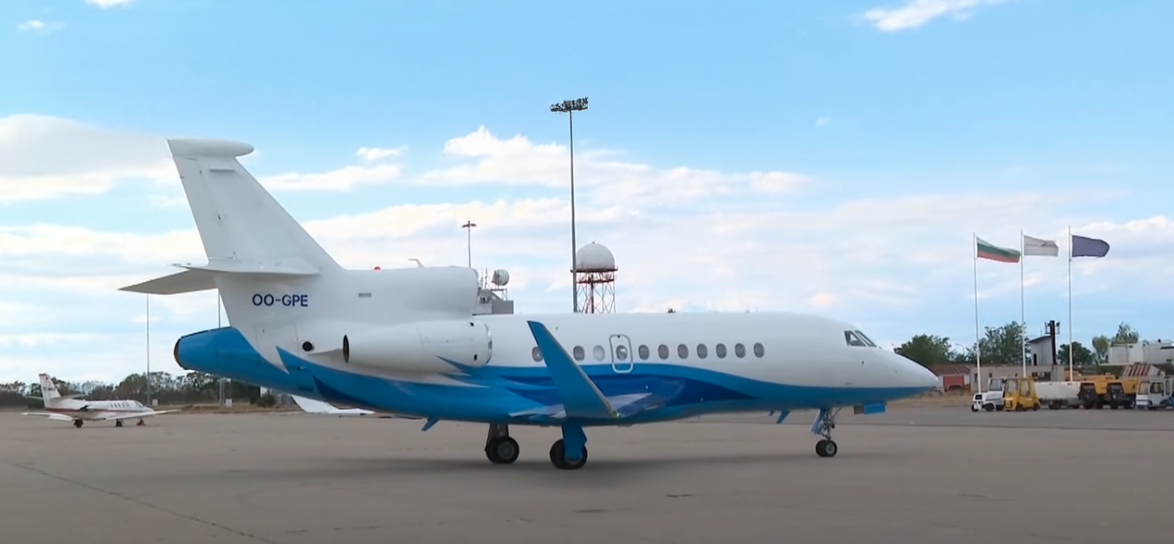|
A chartered aircraft carrying European Commission President Ursula von der Leyen had its GPS navigation system jammed while on approach to Plovdiv in Bulgaria. An EC spokesperson confirmed the incident, which happened on Sunday, saying that Bulgarian authorities suspect the attack was “due to blatant interference by Russia.” Local officials told The Financial Times that pilots had resorted to using hard copy maps to land at Plovdiv Airport (LBPD) after a flight from the Polish capital Warsaw. “The satellite signal transmitting information to the plane’s GPS navigation system was neutralized,” a Bulgarian government spokesman said in a written statement. “To ensure the flight’s safety, air control services immediately offered an alternative landing method using terrestrial navigation tools.” According to footage aired on multiple TV news outlets, including Bloomberg Television, the aircraft carrying Von der Leyen was a Dassault Falcon 900LX. The Belgian-registered jet (tail number OO-GPE) is operated by charter group Luxaviation. Citing "regulatory reasons," the company did not comment directly on the incident, but told AIN that its "pilots have demonstrated full proficiency and adherence to [the] highest safety standards." TV news reports showed Von der Leyen disembarking from the aircraft and being greeted by Bulgarian officials. Later on Sunday, the aircraft flew from Plovdiv to the Lithuanian capital Vilnius. Yesterday, it continued to Constanta in Romania as part of a tour of seven EU states. |
|
|
Garmin once again retained its top spot for overall average in the flight deck avionics rankings in the annual AIN Product Support Survey. Following the release of the results surrounding airframers last month, part two of the Product Support Survey released today deals with aircraft electronic systems: avionics, cabin management systems, and connectivity. In the flight deck avionics segment, Garmin with an average score of 8.8 topped the next closest entry by seven-tenths of a point despite changes to the AIN survey methodology that weighted more toward independent reviews. Garmin also led in the airborne connectivity category with a 9.0 average score. The satellite communications market was roiled in late 2024 when Gogo acquired rival Satcom Direct, the latter of which was among the top scorers in the group this year, with an overall score of 8.6 out of 10, three-tenths of a point above that of its new owner. Under cabin management systems, Gulfstream rose to the top of the list in this year’s results, with the Savannah, Georgia-based company scoring an average of 8.0 in this category, barely edging out Collins Aerospace. |
|
|
Daher has launched a climate policy that targets a 50% reduction in greenhouse gas emissions from its operations by 2032, aligning the company with the Paris Agreement’s 1.5 degrees C target. The French aerospace group, which manufactures aircraft and provides logistics and industrial services, aims to cut emissions by 23% by 2027 as an interim goal. The policy is built around four pillars: operational emissions reduction, upstream supplier engagement, product and service decarbonization, and climate adaptation. Daher plans to expand the use of sustainable aviation fuel (SAF) in its flight operations to more than 10% by 2027 and 20% by 2032. It is also supporting SAF blend approvals beyond 50%. A lower-carbon, hybrid-electric aircraft is scheduled to be developed at the company by 2027, alongside improvements in efficiency for existing platforms. At least half of the company’s research and development budget is now dedicated to composite materials, with an eye to reducing aircraft weight. Daher will also implement eco-design principles across new programs and invest in biofuels for its ground operations. To address Scope 3 emissions, Daher will evaluate the carbon maturity of its 50 highest-emitting suppliers by 2027, expanding the evaluation to 100 suppliers by 2032. Data collected will feed into its internal reporting tools and help define codeveloped reduction pathways for both Scope 1 and Scope 2 categories. |
|
|
Skyport Aviation has taken over the operation of the former commercial aviation terminal at Mississippi’s Hawkins Field Airport (KHKS), near Jackson. The company purchased the former Hawkins Jet Center—the lone service provider on the field—late last year and had been operating from its 2,500-sq-ft terminal, which is attached to a maintenance hangar. With this latest move—in partnership with Jackson Municipal Airport Authority—Skyport has moved its FBO operation into the 5,100-sq-ft airport terminal, which it will share with tenant PHI. The complex has more than 100,000 sq ft of hangar space that can accommodate light jets and turboprops. Skyport v-p Andy Ochalek told AIN the company plans to invest several million dollars into the facility over the next few years for the construction of more hangars to handle ultra-long-range business jets and remodel the terminal. He said the company plans to keep the original FBO terminal for use by a possible tenant, such as a flight school. Florida-based Skyport also operates the sole FBO at airports including Tampa Executive (KVDF) and Venice Municipal (KVNC), as well as in Jacksonville, North Carolina, at Albert Ellis Airport (KOAJ) and at Capital City Executive Airport in Harrisburg, Pennsylvania. |
|
|
Sponsor Content: RTX With improved manufacturing and lessons from a new variant, Pratt & Whitney plans to double time on-wing. |
|
|
A recent paper released by the Brookings Institute calls for tax changes to encourage the increase of privatization of commercial airports in the U.S. Written by Robert Poole, an author at the Reason Foundation who also has long pushed for air traffic control privatization, the paper notes that the U.S. has long had public-private partnerships (P3) in highways and transit, but all but one commercial airport is government-owned. This isn’t the case globally, where airports have been privatized in Australia, Europe, Latin America, and parts of Asia either through sales or long-term P3 leases. In the U.S., Congress has written laws to pave the way for P3 leases, but only San Juan, Puerto Rico, has entered into such a lease, Poole wrote. He added that investors have expressed interest in Chicago Midway and St. Louis Lambert. Airline opposition does not appear to be a significant barrier to such a transition, he maintained. But tax changes to airport financing may be necessary to incentivize privatization. Specifically, he suggested removing the requirement that tax-exempt airport bonds must be paid off before there is a change in control over the facility, such as entering a long-term P3 lease. The other involved expanding the scope of tax-exempt private activity bonds available for surface transportation to include airports and other transportation infrastructure. |
|
|
Researchers at Embry-Riddle Aeronautical University have created an artificial intelligence (AI) system designed to transcribe and translate aviation radio communications. The team said the technology addresses longstanding challenges that pilots and air traffic controllers face with unclear transmissions and aviation-specific phraseology. To convert spoken radio transmissions into standardized text, the system combines automatic speech recognition technology with natural language processing. The AI refines communications by standardizing terminology, formatting call signs and numbers, removing filler words, and identifying potential errors in pilot-controller exchanges. Andrew Schneider, assistant professor in the College of Aviation who directs the university’s Speech and Language AI Lab, leads the project alongside Jianhua Liu, associate professor of electrical and computer engineering. Their research received $30,000 in grants from Embry-Riddle’s Boeing Center for Aviation and Aerospace Safety. Initial testing using off-the-shelf speech recognition tools on recordings from 12 high-traffic U.S. airports revealed significant limitations, with an 80% word error rate. Liu’s signal-processing expertise enabled customization of the automatic speech recognition system, reducing the word error rate to below 15%. The improved performance led to the system’s adoption in a NASA-funded project requiring the extraction of flight deck communications from high-background-noise audio. Future applications include real-time systems that could interface with aircraft systems to detect inconsistencies between verbal instructions and aircraft behavior, flag missed communications, or assist with checklist verification. |
|
|
Air charter broker P3 Jets, formerly known as PorterJets, has officially relaunched with a new name, brand identity, and expanded suite of services tailored for integrated luxury travel experiences across air, land, and sea. As part of the relaunch, P3 Jets has introduced several additional offerings. Jet card clients can now access personalized itinerary planning, on-demand ground transportation, and private yacht charters. A newly expanded lifestyle design team can handle end-to-end trip planning for high-net-worth travelers, while a redesigned website includes a private jet card comparison tool. The Nashville-based company said the rebrand responds to growing client demand for seamless, all-encompassing travel. “We’ve entered a pivotal stage in our evolution,” said founder and CEO Dan Naaman. “Our new name…more accurately represents the full scope of what we now offer across air, land, and sea.” Launched as PorterJets in 2024, the company reported more than 625 flights ahead of its formal public debut last November. It began offering flight arrangements with Part 135 and 121 operators, arranging aircraft sales, and providing ground transfer, yacht, and local experience coordination. “This isn’t just a rebrand; it’s a repositioning,” said Joe Naaman, chief strategy, finance, and operations officer. “Travelers expect seamless experiences…P3 Jets is built to meet that demand.” |
|
|
Runway 9/27 at Boston Logan International Airport (KBOS) closed today for the start of the first of two 75-day safety construction project phases. The $110 million project, which will be largely funded by the FAA, will install an engineered material arresting system (EMAS) at the end of Runway 27, which abuts Boston Harbor. “EMAS is a vital safety system at Boston Logan and other airports located near water or ground elevation changes,” said Massport, which operates the airport. Constructed of a lightweight, collapsible material, it is intended to stop an airplane that has overshot the runway. In place at airports around the world, EMAS has prevented scores of serious accidents. The project at KBOS will construct a pile-supported deck over the harbor to extend the runway safety area to a length of 650 feet from the runway’s end, along with emergency access ramps on either side of the deck. Massport noted that this is a required FAA safety project that does not extend the runway or change its operational capacity. Following a second 75-day closure in third-quarter 2026, Runway 27 will be the third at KBOS to be equipped with EMAS, joining Runways 22R and 33L. Massport noted that during the closure periods, there will be an impact on the number of airplanes that can land and take off at KBOS, which could cause possible delays or diversions. |
|
|
Buying an Aircraft with a Broker We spoke with Zipporah Marmor, an International Aircraft Dealers Association-certified broker. She explains what buyers should consider when buying an aircraft.
|
|
|
|
|
|
|
AINalerts News Tips/Feedback: News tips may be sent anonymously, but feedback must include name and contact info (we will withhold name on request). We reserve the right to edit correspondence for length, clarity, and grammar. Send feedback or news tips to AINalerts editor Chad Trautvetter. |
|
AINalerts is a publication of AIN Media Group, 214 Franklin Avenue, Midland Park, New Jersey. Copyright 2025. All rights reserved. Reproduction in whole or in part without permission is strictly prohibited. |







.gif)









